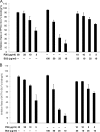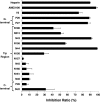Identification of amino acid residues important for heparan sulfate proteoglycan interaction within variable region 3 of the feline immunodeficiency virus surface glycoprotein
- PMID: 21543468
- PMCID: PMC3126603
- DOI: 10.1128/JVI.00573-11
Identification of amino acid residues important for heparan sulfate proteoglycan interaction within variable region 3 of the feline immunodeficiency virus surface glycoprotein
Abstract
Heparan sulfate proteoglycans (HSPGs) act as binding receptors or attachment factors for the viral envelope of many viruses, including strains of HIV and feline immunodeficiency virus (FIV). The FIV gp95 glycoprotein (SU) from laboratory-adapted strains (tissue culture adapted [TCA]) such as FIV-34TF10 can bind to HSPG, whereas SU from field strains (FS) such as FIV-PPR cannot. Previous studies indicate that SU-HSPG interactions occur within the V3 loop. We utilized a series of nested V3 peptides to further map the HSPG binding sites and found that both sides of the predicted V3 loop stem were critical for the binding but not the CXCR4 binding domain near the predicted tip of the V3 loop. Neutralization assays for TCA strain entry using the same set of V3 peptides showed that peptides targeting CXCR4 or HSPG binding sites can block infection, supporting the V3 loop as a critical neutralization target. Site-directed mutagenesis identified two highly conserved arginines, R379 and R389, on the N-terminal side of the V3 stem as critical for the contact between SU and HSPG. Residues K407, K409, K410, and K412 on the C-terminal side of the V3 stem form a second nonconserved domain necessary for HSPG binding, consistent with the observed specificity distinctions with FS FIV. Our findings discriminate structural determinants important for HSPG and CXCR4 binding by FIV SU and thus further define the importance of the V3 loop for virus entry and infection.
Figures






Similar articles
-
Selective interaction of heparin with the variable region 3 within surface glycoprotein of laboratory-adapted feline immunodeficiency virus.PLoS One. 2014 Dec 18;9(12):e115252. doi: 10.1371/journal.pone.0115252. eCollection 2014. PLoS One. 2014. PMID: 25521480 Free PMC article.
-
Factors that increase the effective concentration of CXCR4 dictate feline immunodeficiency virus tropism and kinetics of replication.J Virol. 2004 Sep;78(17):9132-43. doi: 10.1128/JVI.78.17.9132-9143.2004. J Virol. 2004. PMID: 15308709 Free PMC article.
-
Mapping of the CXCR4 binding site within variable region 3 of the feline immunodeficiency virus surface glycoprotein.J Virol. 2008 Sep;82(18):9134-42. doi: 10.1128/JVI.00394-08. Epub 2008 Jul 2. J Virol. 2008. PMID: 18596086 Free PMC article.
-
Human immunodeficiency virus and heparan sulfate: from attachment to entry inhibition.Front Immunol. 2013 Nov 20;4:385. doi: 10.3389/fimmu.2013.00385. Front Immunol. 2013. PMID: 24312095 Free PMC article. Review.
-
The virus-receptor interaction in the replication of feline immunodeficiency virus (FIV).Curr Opin Virol. 2013 Dec;3(6):670-5. doi: 10.1016/j.coviro.2013.08.003. Epub 2013 Aug 28. Curr Opin Virol. 2013. PMID: 23992667 Free PMC article. Review.
Cited by
-
Selective interaction of heparin with the variable region 3 within surface glycoprotein of laboratory-adapted feline immunodeficiency virus.PLoS One. 2014 Dec 18;9(12):e115252. doi: 10.1371/journal.pone.0115252. eCollection 2014. PLoS One. 2014. PMID: 25521480 Free PMC article.
-
Pharmacological inhibition of feline immunodeficiency virus (FIV).Viruses. 2012 May;4(5):708-24. doi: 10.3390/v4050708. Epub 2012 Apr 27. Viruses. 2012. PMID: 22754645 Free PMC article. Review.
-
Mapping of Receptor Binding Interactions with the FIV surface Glycoprotein (SU); Implications Regarding Immune surveillance and cellular Targets of Infection.Retrovirology (Auckl). 2012 Jul 11;2012(4):1-11. doi: 10.4137/RRT.S9429. Retrovirology (Auckl). 2012. PMID: 23255871 Free PMC article.
-
Mutations in the feline immunodeficiency virus envelope glycoprotein confer resistance to a dominant-negative fragment of Tsg101 by enhancing infectivity and cell-to-cell virus transmission.Biochim Biophys Acta. 2014 Apr;1838(4):1143-52. doi: 10.1016/j.bbamem.2013.08.020. Epub 2013 Sep 10. Biochim Biophys Acta. 2014. PMID: 24036228 Free PMC article.
-
Replacement of the V3 domain in the surface subunit of the feline immunodeficiency virus envelope glycoprotein with the equivalent region of a T cell-tropic human immunodeficiency virus type 1 results in a chimeric surface protein that efficiently binds to CXCR4.AIDS Res Hum Retroviruses. 2014 Mar;30(3):250-9. doi: 10.1089/AID.2013.0213. Epub 2013 Nov 12. AIDS Res Hum Retroviruses. 2014. PMID: 24148007 Free PMC article.
References
-
- Andrianov A. M., Veresov V. G. 2007. Structural analysis of the HIV-1 gp120 V3 loop: application to the HIV-Haiti isolates. J. Biomol. Struct. Dyn. 24:597–608 - PubMed
-
- Bobardt M. D., et al. 2003. Syndecan captures, protects, and transmits HIV to T lymphocytes. Immunity 18:27–39 - PubMed
-
- Cardin A. D., Weintraub H. J. 1989. Molecular modeling of protein-glycosaminoglycan interactions. Arteriosclerosis 9:21–32 - PubMed
-
- de Parseval A., et al. 2005. A highly conserved arginine in gp120 governs HIV-1 binding to both syndecans and CCR5 via sulfated motifs. J. Biol. Chem. 280:39493–39504 - PubMed
Publication types
MeSH terms
Substances
Grants and funding
LinkOut - more resources
Full Text Sources

